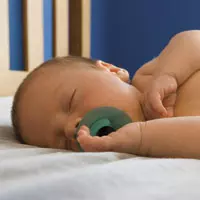Pacifier Pros and Cons: The Great Pacifier Debate
Pacifier Pros and Cons. Should you or shouldn’t you? Many moms have strong feelings about this choice, and it may not be as clear-cut as you think!
Babies have a strong sucking reflex, and may even be born with sucking blisters on hands and fingers. This natural reflex is soothing and calming for your baby; you shouldn’t discourage it. While some babies calm themselves with their fingers, and others take well to a pacifier, there are pros and cons to each approach.
For example, pacifiers are associated with a reduction in sudden infant death syndrome (SIDS), so after breastfeeding is established the AAP recommends using pacifiers when placing infants to sleep for up to 1 year. There is no need to put the pacifier back in once baby falls asleep. Pacifiers may increase the risk of ear infections, though the risk of ear infections is lowest when SIDS benefit is highest (from 0-6 months).
SEE ALSO: Sudden Infant Death Syndrome and Does My Baby Have An Ear Infection?
The variety of pacifiers is overwhelming, including orthodontic or flat shape, one piece or two, vented or not. You can choose your own shapes and colors, sports teams or monograms without breaking the bank. The most common nipple choices are silicone, which is harder, more durable, doesn’t hold odors and is easier to clean; and latex which is softer, holds scents, breaks down faster, and may pose an allergy risk.
Safe pacifier use
For safety purposes the AAP recommends pacifiers be at least 1.5 inches across to prevent swallowing; always follow age recommendations on the package. Never tie a pacifier around your baby’s neck and be sure that any clip used is very short. While your child is 6 months old or younger, pacifiers require frequent boiling or dishwasher sterilization. After 6 months, soap and water are okay but please don’t put it in your mouth as a quick fix!
Never coat a pacifier with sugar or honey, don’t share, check all of its parts frequently and replace after it is worn out. Avoid the temptation to create a homemade pacifier; these and gel-filled ones aren’t safe.
SEE ALSO:
Bottles, Pacifiers & Your Baby’s Oral Health
Best pacifier practices
If you’ve decided to use a pacifier, wait until breastfeeding is well established (usually between 2-4 weeks). First try other ways to soothe your baby, such as rocking, massage or music before giving a pacifier. Choose a pacifier that is one piece, preferably silicone, dishwasher-safe and use between feedings only. Ultimately smart moms go with what baby likes; let her choose when to use the pacifier and then relax!
Should Your Baby Use a Pacifier Pros and Cons?
Pros
- Reduces SIDS risks
- Soothes infant between feedings
- May help infant fall asleep
- Temporary distraction during checkups or shots
- Eases ear discomfort in flights
Cons
- May interfere with breastfeeding
- Baby may become dependent
- Prolonged use can cause dental problems
- May increase ear infections
FURTHER READING:
How to Relieve Your Infant’s Pain
Smart Nursery: How Smart Is Your Baby’s Nursery?
Keeping Baby Safe from the Start
There are many more must read articles in our Newborn Care section






Comments are closed.